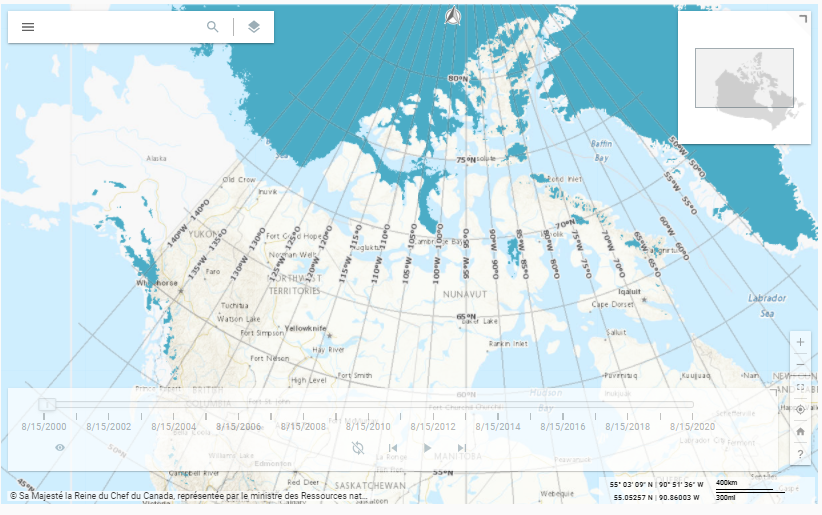Neige
Type of resources
Available actions
Keywords
Contact for the resource
Provided by
Years
Representation types
Update frequencies
status
Service types
-

Snow and ice are important hydrological resources. Their minimum spatial extent here referred to as annual minimum snow/ice (MSI) cover, plays a very important role as an indicator of long-term changes and baseline capacity for surface water storage. The MSI probability is derived from sequence of seventeen 10-day clear-sky composites corresponding to April, 1 to September, 20 warm period for each year since 2000. Data from Moderate Resolution Imaging Spectroradiometer (MODIS) on Terra satellite for the period since 2000 have been processed with the special technology developed at the Canada Centre for Remote Sensing (CCRS) as described in Trishchenko, 2016; Trishchenko et al., 2016; 2009, 2006, Trishchenko and Ungureanu, 2021, Khlopenkov and Trishchenko, 2008, Luo et al., 2008. The presence of snow or ice is determined for each pixel of the image based on snow/ice scene identification procedure and the probability if computed for the entire warm season as a ratio of number of snow/ice flags to the total number of pixels available (less or equal to 17). The minimum snow and ice extent can be derived from the probability map by applying a certain threshold. New data version V5.0 replaces previous version V4.0 for all data available since 2000. All MSI files were reprocessed for all MODIS input data based on collection 6.1. The output format has not changed since previous version. It is described in Trishchenko (2024). The impact of input data change is small and can be detected only for time interval 2000-2015. Data starting 2016 has been already derived using MODIS collection 6.1 input. The differences between the MSI data based on MODIS Collection 5 (i.e. MSI V4) versus MODIS Collection 6.1 (i.e. MSI V5), on average, are quite small. The region-wide relative difference in the MSI extent varies from -3.97% to +1.75%. The mean value is -0.14%, the median value is 0.18% and standard deviation is 1.83%. As such, we do not expect any sizeable impact of the version change on our previous conclusions regarding trends and climate variations, except for refining the relative values of statistical parameters within the range of a few percents. References: TRISHCHENKO, A.P., 2024: Probability maps of the annual minimum snow and ice (MSI) presence over April,1 to September, 20 period since 2000 derived from MODIS 250m imagery over Canada and neighbouring regions. Data format description. CCRS, NRCan. 4pp.
-

The daily climate records database, also known as Long Term Climate Extremes (LTCE), was developed to address the fragmentation of climate information due to station changes (opening, closing, relocation, etc.) over time. For approximately 750 locations in Canada, "virtual" climate stations have been developed by joining (threading) climate data for an urban location, from nearby stations to make long-term records. Each long-term record consists of the extremes (record values) of daily maximum/minimum temperatures, total precipitation and snowfall for each day of the year. Many of the longest data sets of extremes date as far back as the 1800s. This data provides the daily extremes of record for Snowfall for each day of the year. Daily elements include: Greatest Snowfall.
-

Data set containing the list and location of snow disposal sites used by the City of Montreal during snow loading periods, including information on each site. The sets on [snow removal sectors] (/city-of-montreal/sector-deenigement), the [contracts and transactions] (/city-of-montreal/contrats-transaction-de-neigement) are also available on the portal.**This third party metadata element was translated using an automated translation tool (Amazon Translate).**
-

The set contains geospatial data for snow removal sectors in the City of Montreal as well as the boroughs associated with them. The packages on the [snow disposal sites] (/city-of-montreal/depot-snow), the [contracts and transactions] (/city-of-montreal/contrats-transaction-de-neigement) are also available on the portal.**This third party metadata element was translated using an automated translation tool (Amazon Translate).**
-

The Annual Minimum Snow and Ice (MSI) Extent of the Atlas of Canada National Scale Data, are data sets compiled containing annual data from 2000 to present. The data sets were derived from research published by the Canada Centre for Remote Sensing which classified satellite imagery over Canada and neighbouring regions for the continued presence or absence of snow and ice from April 1 to September 20 each year. The Atlas of Canada MSI products consist of a vector dataset and a raster time-series animation application. VECTOR DATASET The vector dataset has been generalized to display at the scale of 1:1,000,000. TIME-SERIES ANIMATION APPLICATION The time-series animation application has not been generalized from its original scale (250 m pixels). The application is disseminated through the Data Cube Platform, implemented by the Canada Centre for Mapping and Earth Observation, Natural Resources Canada using geospatial big data management techniques. These technologies enable the rapid and efficient visualization of high-resolution geospatial data and allow for the rapid generation of dynamically derived products. The time-series is also available as a Web Map Service (WMS) and Web Coverage Service (WCS). CREDIT Source data provided by Alexander P. Trishchenko, Canada Centre for Remote Sensing, Natural Resources Canada Metadata record: https://open.canada.ca/data/en/dataset/808b84a1-6356-4103-a8e9-db46d5c20fcf
-

Location of free and paid parking lots available during snow removal operations. The data is also visible on the [311 Montreal] application (https://donnees.montreal.ca/fr/showcase/311-montreal-info-deneigement-alertes) and on the [map of snow removal operations] (https://montreal.ca/services/carte-des-operations-de-deneigement).**This third party metadata element was translated using an automated translation tool (Amazon Translate).**
-
GeoMet-Météo du SMC rend publiquement accessible les données du Service météorologique du Canada (SMC) et d'Environnement et Changement climatique Canada (ECCC) via des services web interopérables et des interfaces de programme (API). Par le biais de standards ouverts, ces services donnent rapidement et gratuitement accès à des milliers de jeux de données et produits météorologiques, climatiques et hydrométriques en temps réel et archivés qui peuvent être intégrés dans les applications spécifiques de l'usager et leurs systèmes d'aide à la décision. Les usagers peuvent développer des applications mobiles, créer des cartes interactives en-ligne, ainsi que de visualiser et animer les données du SMC dans des logiciels de bureau. Les services GeoMet du SMC rendent également possible le découpage de données et la reprojection sur demande, tout autant que la conversion de formats et la visualisation personnalisée de couches de données.
-

Service showing the status (on or off) of flashing lights on the street.**This third party metadata element was translated using an automated translation tool (Amazon Translate).**
-

The Multi-Risk Vigilance Card is a product developed by the Ministry of Public Security (MSP) that brings together warnings and reports on phenomena of natural origin that may have consequences on the safety of citizens, goods and services to the population. It is updated continuously automatically. It allows for continuous monitoring of the province's territory in relation to dangerous natural phenomena. Environment and Climate Change Canada weather warnings for blizzard, fog, freezing rain, rain, fog, freezing rain, rain, snow, hail, hurricanes, tropical storms, winter storms, severe storms, tornadoes, tornadoes, storm winds, storm winds, strong winds, strong winds, strong winds, hurricane force winds, high winds, hurricane-force winds, heat waves, and all weather events whose severity* is greater than or equal to moderate; This data comes from the National Alert Aggregation and Dissemination System (ADNA) of the private company Pelmorex. The information conveyed in the alerts complies with the standards of the Common Alert Protocol (PAC). **This third party metadata element was translated using an automated translation tool (Amazon Translate).**
-

This is a map of current snow basin indices across British Columbia. Snow basin index mapping is based on analysis from the River Forecast Centre, and is meant to accompany the Snow Conditions and Water Supply Bulletins that are published for data from January 1st, February 1st, March 1st, April 1st, May 1st, May 15th, June 1st and June 15th each year. Snow data collection is managed by the Ministry of Environment and Climate Change Strategy's Snow Program.
 Arctic SDI catalogue
Arctic SDI catalogue